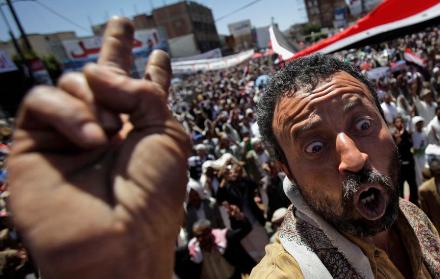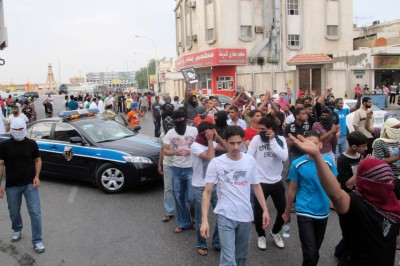A massive show of force snuffed out a Facebook-based effort to stage unprecedented pro-democracy protests in the capital of Saudi Arabia on Friday but political unrest and sectarian tensions roiled neighboring Yemen and Bahrain.

Yemen’s largest demonstrations in a month were met by police gunfire that left at least six protesters injured and seemed all but certain to fuel more anger against the U.S.-allied but deeply unpopular president.
In Bahrain, a conflict deepened between the island kingdom’s Shiite majority and its Sunni Muslim royal family, whose security forces and pro-government mobs attacked demonstrators with tear gas, rocks and swords in the home of the U.S. Navy’s 5th Fleet. Defense Secretary Robert Gates visited the kingdom to reassure its rulers that the U.S. remains committed to their partnership, officials said.
With uprisings threatening allies on its eastern and southern flanks, the Sunni Saudi monarchy appeared to be taking no chances in its effort to keep the popular push for democracy in the Arab world from spreading to the world’s largest crude oil exporter.
In the heavily Shiite eastern Saudi city of Qatif, a short drive from Bahrain, armored personnel carriers and dozens of officers in riot gear surrounded several hundred demonstrators shouting calls for reforms and equality between the sects. Police opened fire in the city to disperse a protest late Thursday in an incident that left three protesters and one officer wounded, but there was no repeat of that violence.

Yemen’s president of 32 years appeared to be one of the leaders most threatened by the regional unrest inspired by pro-democracy revolts in Egypt and Tunisia.
Hundreds of thousands of protesters gathered in Yemen’s four largest provinces, ripping down and burning Saleh’s portraits in Sheikh Othman, the most populated district in the southern port city of Aden, witnesses said.
Security forces hurled tear gas into crowds close to a stadium and then opened fire, using machine guns mounted on vehicles, said eyewitness Sind Abdullah, 25.
Thousands of women participated in demonstrations in the conservative capital, Sanaa — a startling move in a deeply tribal society where women are expected to stay out of sight.
Demonstrators demanded jobs and greater political freedom and decried Saleh’s proposal Thursday that the government create a new constitution guaranteeing the independence of parliament and the judiciary, calling it too little and too late.
The autocratic leader is also an ally in the Obama adminstration’s push to eliminate the local branch of al-Qaida, which has attempted to attack the United States. He has also worked closely with the Saudis to quash his own Shiite uprising in the north.
In the Saudi capital, security forces who took up positions on corners and intersections as at least one helicopter buzzed overhead. Police blocked roads and set up random checkpoints, searching residents and vehicles around a central mosque as large numbers of people gathered for Friday prayers.
Government minders escorted journalists around the city, where they were shown a man, who gave his name as Khaled al-Juhni, standing outside a government building, shouting calls for more freedoms.
Police and journalists watched as the man criticized the regime as a “police state” and “a big prison” before he got in his car and left.
No other protests had showed up in the capital and the police presence significantly decreased.
A government official said security measures around state-run oil giant Saudi Aramco and its oil facilities in the east were beefed up protectively in case of any violence. The company is based in the Dhahran district on the kingdom’s eastern coast.
Investors are sensitive to any sign of upheaval in Saudi Arabia because the OPEC leader has been using its spare capacity to make up for output lost amid the violent uprising against Libya’s government. When news broke that Saudi Arabian police fired shots to break up the protest Thursday, prices soared $3 in just 12 minutes.
Shiites make up 10 percent of the kingdom’s 23 million citizens and have long complained of discrimination, saying they are barred from key positions in the military and government and are not given an equal share of the country’s wealth.
Last month, the ultraconservative Saudi government announced an unprecedented economic package worth an estimated $36 billion that will give Saudis interest-free home loans, unemployment assistance and debt forgiveness.
At the same time, it reiterated that demonstrations are forbidden in the kingdom.
So far the demonstrations have been small, concentrated in the east among Shiites demanding the release of detainees. But activists set up Facebook groups calling for protests in Riyadh and one group garnered more than 30,000 supporters of its demands for free elections. AP
Leave a Reply
You must be logged in to post a comment.